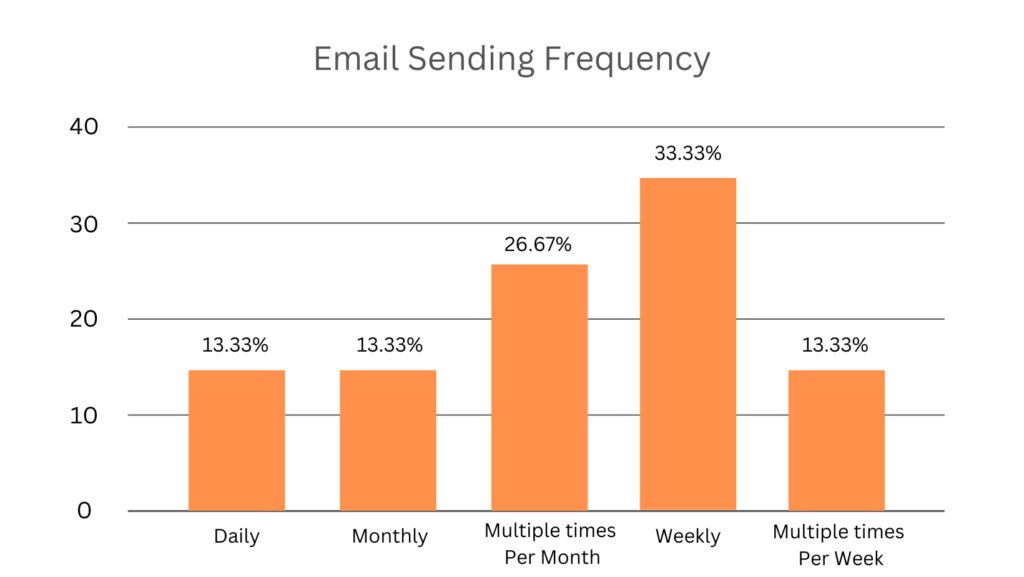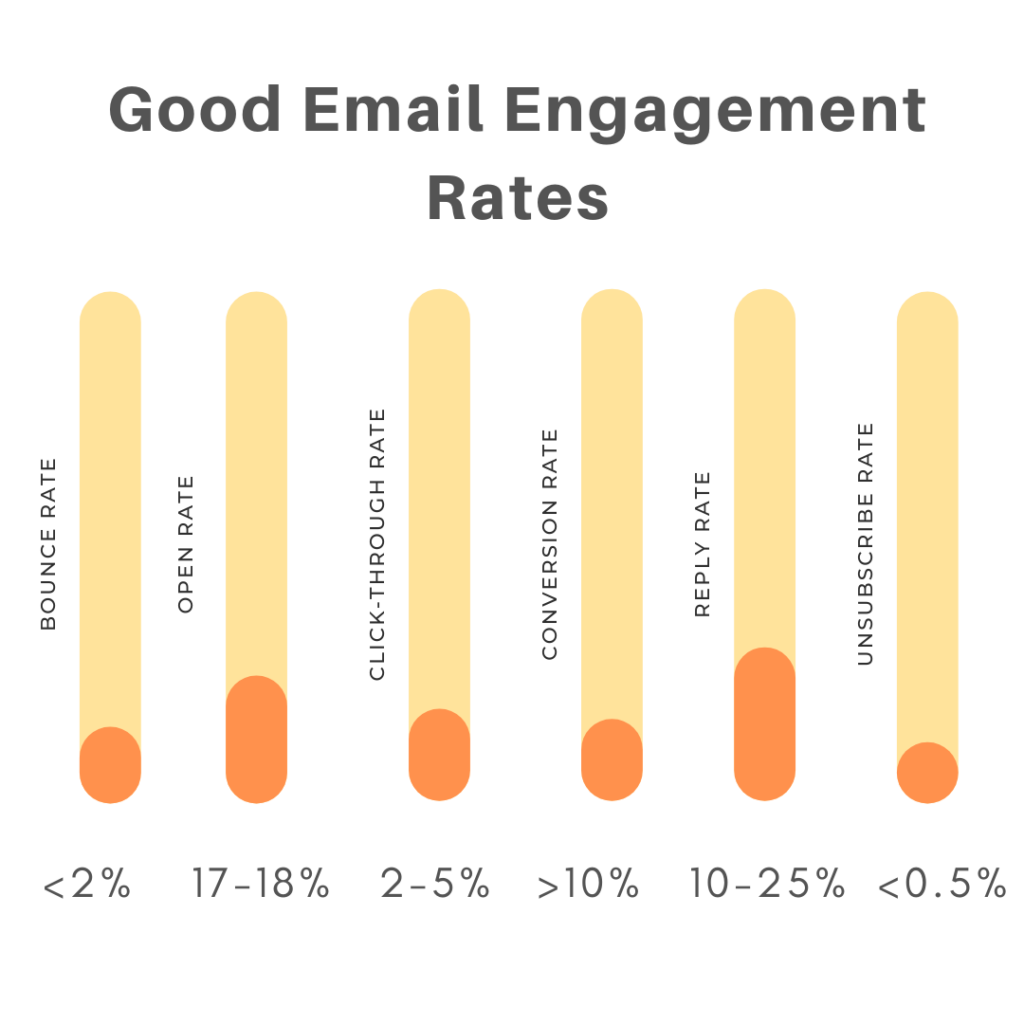Email marketing is a powerful tool for businesses to connect with their audience. However, the frequency of emails remains a critical factor. It’s no secret that email frequency plays a significant role in whether your emails end up in the inbox or get lost in the dreaded spam folder.
According to recent statistics, a majority of marketers opt for a weekly email schedule.

However, the burning question remains: How many marketing emails to send per week without triggering the spam filters?
Well, the top factor that spam filters look at while flagging your emails as spam or not is the sender’s reputation.
So, let’s first decode the relationship between the sender’s reputation and the email frequency.
Sender Reputation and Email Frequency
Sender reputation plays a major role in avoiding spam filters. Internet Service Providers (ISPs) use sender reputation to determine whether an email should be delivered to the inbox or flagged as spam. Hence, maintaining a stellar sender reputation is the cornerstone of successful email marketing.
Tips to maintain a strong sender reputation:
1. Consistent Sending Schedule
Establish a regular and consistent sending schedule. Erratic sending patterns can be flagged as suspicious by email service providers (ESPs).
2. Segmentation and Personalization
Segment your email list based on user behavior, preferences, and demographics. Tailor your emails to specific segments to increase relevance and engagement.
3. Quality Content
Focus on delivering high-quality, valuable content. Content that resonates with your audience is more likely to be opened, clicked, and shared.
4. Avoid Spam Triggers
Craft your emails to avoid common spam triggers, such as excessive use of all caps, misleading subject lines, or overly aggressive sales language.
5. Prune Inactive Subscribers
Regularly clean your email list by removing inactive or unengaged subscribers. This not only improves deliverability but also ensures that you’re targeting an audience genuinely interested in your content.
6. Authentication Protocols
Implement email authentication protocols such as SPF (Sender Policy Framework) and DKIM (DomainKeys Identified Mail) to verify your identity and prevent email spoofing.
7. Monitor and Analyze Metrics
Keep a close eye on email performance metrics such as open rates, click-through rates, and bounce rates. Analyze these metrics to identify trends and adjust your strategy accordingly.

A cold email automation tool like SafeMailer can help you here. It will help you schedule and send your emails in a human-like sending pattern.
How many marketing emails to send per week when you have a low sender reputation?
When your sender reputation is low, it’s imperative to tread cautiously in terms of email frequency. Sending too many emails when your reputation is already compromised can exacerbate the situation.
Here’s a wise approach to consider:
- Reduce Frequency: Scale back your email frequency to give your sender reputation a chance to recover. Consider sending emails once every two weeks or even less frequently.
- Focus on Engagement: Prioritize engagement over volume. Craft compelling, relevant content that encourages opens, clicks, and positive interactions. Monitor your metrics regularly and alter the strategy accordingly.
- Cleanse Your List: Weed out inactive or unengaged subscribers from your email list. A smaller, more engaged audience can positively impact your sender reputation.
How many marketing emails to send per week when you have a high sender reputation?
A high sender reputation opens the door to more flexibility in your email marketing strategy. ESPs recognize you as a reliable sender, allowing you to experiment with a slightly more aggressive approach:
- Optimize Frequency: With a strong sender reputation, you can consider increasing your email frequency within reasonable bounds. Sending two to three times per week is a common benchmark for maintaining engagement without overwhelming subscribers.
- Monitor and Adjust: Even with a high sender reputation, it’s crucial to continuously monitor your email performance metrics. If you notice any signs of subscriber fatigue or declining engagement, be prepared to adjust your strategy accordingly.
How many marketing emails to send per week – Ideal frequency
Research by Campaign Monitor indicates that sending emails2-3 times per week appears to be the sweet spot for most marketers. This frequency keeps subscribers engaged without risking email fatigue.
However, your ideal frequency should resonate with your specific audience. For some businesses, a weekly email might suffice, while others may find success with a slightly higher frequency.
Striking this balance is key to optimizing your email marketing strategy.
When You Have a New Account-
Starting with a new email account requires careful consideration. Bombarding your audience with emails from the get-go can lead to high unsubscribe rates and a damaged sender reputation.
The best practice is to warm up your account. It’s advisable to start slow, gradually increasing your email frequency as your subscribers become accustomed to your content.
This approach will help in building a good sender reputation.
Finding Your Ideal Frequency
The ideal email frequency is not a one-size-fits-all concept. It depends on various factors, and one effective approach is to let your audience guide you.
The Type of Business
Different businesses cater to diverse audiences with varying expectations. For instance, a daily deals website might benefit from daily emails, while a monthly newsletter could suffice for a niche consultancy.
Understanding your business model and your audience’s preferences is crucial in determining the right frequency.
Here are some stats that can guide you:
- E-commerce: Best practice: 1-3 emails per week. Retail businesses often find success with a mix of promotional, informational, and personalized content.
- B2B (Business-to-Business): Best practice: 1-2 emails per week. B2B audiences may prefer less frequent emails with valuable, educational content.
- B2C (Business-to-Consumer): Best practice: 2-4 emails per month.B2C companies might experiment with more frequent emails, especially for time-sensitive promotions.
- News and Media: Best practice: 2-5 emails per week. News organizations can send more frequent updates, but it’s crucial to balance volume with relevance.
- SaaS (Software as a Service): Best practice: 1-2 emails per week.SaaS companies often benefit from a mix of product updates, educational content, and customer success stories.
- Nonprofits: Best practice: 1 email every two weeks. Nonprofits should focus on storytelling, impact updates, and fundraising appeals without overwhelming supporters.
Engagement Rate
Regularly monitor your email engagement metrics. A high engagement rate often suggests that your audience is receptive to your content. If your subscribers eagerly anticipate your emails, you might find room to increase your frequency.
On the other hand, a decline in engagement might signal that it’s time to reassess your email strategy. The following are industry benchmarks for email engagement rates for your reference.
Content Quality
Quality always trumps quantity. If your emails consistently provide value and resonate with your audience, they are more likely to welcome frequent communication. Assess the relevance and significance of your content to ensure that it aligns with your audience’s interests and needs.
The key is to find the right balance between staying top-of-mind and not overwhelming your audience is crucial.
Conclusion
So, how many marketing emails to send per week? Well, the key here is finding the right balance between annoying and not engaging with your audience.
By maintaining a strong sender reputation, you can experiment as per your audience’s preferences, and by delivering high-quality content, you can strike the perfect chord.
Remember, the key is not just how many marketing emails you send per week, but rather how well they resonate with your audience and contribute to a positive overall user experience.

Leave a Reply